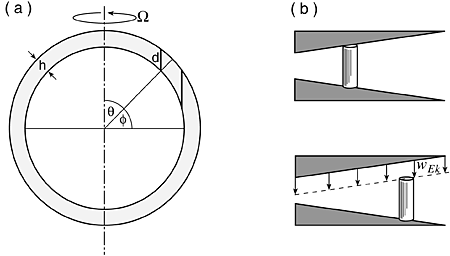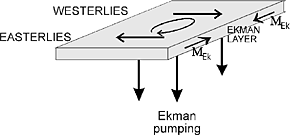Introduction | Tank – How to | Tank – Examples | Theory | Wiki
The varying depth of the tank – in the direction parallel to the rotation vector – mimics the variation of the ocean depth measured in the direction parallel to the rotation vector on the sphere – see Fig.1. The shallow end of the tank is analogous to the poleward side of the ocean basin and the deep end to the tropical side, as can be deduced from the diagram below
Fig.1 An illustration of Taylor-Proudman on a rotating sphere. We draw a spherical shell of homogeneous fluid of constant thickness h. The length of the Taylor columns, d, aligned parallel to Ω, increase as the equator is approached. (b) If fluid is pumped down from the top of the wedge at a rate wEk, the Taylor column moves equatorwards. This is the primary drive mechanism of the wind-driven ocean circulation.
The stress applied by fans at the surface of the water is analogous to the wind stress on the ocean surface. If the fans are arranged to provide, for example, an anticyclonic wind-stress, fluid is drawn inwards in the Ekman layer and pumped downwards in to the interior, mimicking the pumping down of water in subtropical gyres by the action of the winds, as sketched in Fig.2.
Fig.2 A schematic showing midlatitude westerlies (eastwad wind stress) and tropical easterlies (westward stress) blowing over the ocean. Because the Ekman transport is to the “right of the wind” in the northern hemisphere, there is convergence and downward Ekman pumping in the interior of the ocean. Note that the sea surface is high in region of convergence.

